
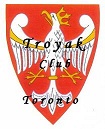
TROYAK EXECUTIVE TEAM is informing all members, colleagues, collectors, and Polonia at large, that Club meetings taking place at John Paul II Polish Cultural Centre, 4300 Cawthra Rd. (just south of Hwy. 403), Mississauga, Ontario. The new members are always welcome. www.polishculturalcentre.ca
ADRES SPOTKAÑ KLUBOWYCH ! Zarząd Główny Klubu “Troyak” informuje wszystkich członków kolekcjonerów, sympatyków oraz całą Polonię, że spotkania klubowe odbywają się w Polskim Centrum Kultury im. Jana Pawła II, przy 4300 Cawthra Rd. (na południe od autostrady 403), Mississauga, Ontario. Zapraszamy nowych członków do prężnego. Klubu “Troyak”. www.polishculturalcentre.ca

“TROYAK” CLUB NEXT MEETINGS …
NASTĘPNE SPOTKANIA KLUBU “TROYAK” …
Sunday 28th May 2023 @ 4:30 p.m.
25th June 2023

July & August 2023 – Summer break … Letnie wakacje …

TROYAK CLUB @ Roncesvalles Polish Festival 2023
Saturday, September 16th & Sunday, September 17th, 2023
https://polishfestival.ca www.kazimierz.org
St. Casimir’s Church
Parish Hall … 156 Roncesvalles Ave. Toronto, Ontario
Stamp Exhibit … Pope John Paul II on World Stamps and
Displays of Coins, Stamps, Collectibles by Troyak Club Members.
Roncesvalles Polish Festival
www.troyakclub.com
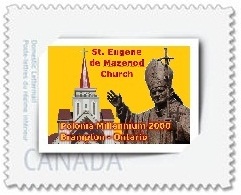
30th September 2023
29th October 2023
26th November 2023
Sunday – 3rd December 2023 @ 9:00 a.m. to 4:00 p.m.
Mississauga Coin & Stamp Show
December 2023 … Happy Holidays!


10. rocznica pontyfikatu papieża Franciszka
www.poczta-polska.pl
W dniu 13 marca 2023 r. został wprowadzony do obiegu znaczek pocztowy o wartości 4,00 zł emisji “10.rocznica pontyfikatu papieża Franciszka”. Znaczki wydrukowano techniką offsetową , na papierze fluorescencyjnym, w formacie znaczka 51mm x 31,25 mm, w nakładzie 128.000 sztuk. Arkusz zawiera 8 znaczków. Na znaczku przedstawiono wizerunek papieża Franciszka na podstawie fotografii Grzegorza Gałązki, w górnym lewym rogu znaczka umieszczono nazwę emisji a w górnym prawym rogu napis: Polska i oznaczenie wartości: 4,00 ZŁ. Na kopercie FDC umieszczono herb papieża Franciszka. Wydanie poświęcone 10.rocznicy pontyfikatu papieża Franciszka powstało przy ścisłej współpracy z Nuncjaturą Apostolską w Polsce. Z tej okazji została wydana koperta FDC, autor projektu znaczka: Poczta Polska.
Z okazji 10. rocznicy pontyfikatu papieża Franciszka Poczta Polska wprowadziła do obiegu nowy znaczek pocztowy. Walor jest podziękowaniem dla Ojca Świętego za Jego duchowe przywództwo Kościołowi katolickiemu na całym świecie. Równo dziesięć lat temu, 13 marca 2013 roku, w drugim dniu konklawe, arcybiskup metropolita Buenos Aires i Prymas Argentyny – kardynał Jorge Mario Bergoglio został wybrany 266. papieżem Kościoła katolickiego, przyjmując imię Franciszek. Tym samym Ojciec Święty wskazał wzór, który dostrzegał w postawie św. Franciszka z Asyżu.

Przez dziesięć lat pontyfikatu papież Franciszek poprzez odbyte pielgrzymki, spotkania, przemówienia, homilie i publikowane dokumenty, konsekwentnie realizuje drogę braterstwa i dialogu, zmieniając krok po kroku oblicze Kościoła.
– Poczta Polska swoim okolicznościowym walorem filatelistycznym pragnie podkreślić wyjątkowe dokonania papieża Franciszka podczas swojej dziesięcioletniej służby na Stolicy Piotrowej. Znaczek pocztowy to symbol głębokiego szacunku i podziękowania dla Ojca Świętego. Mamy nadzieję, że walor honorujący wyjątkowe dzieło duchowego przywódcy Kościoła, wkrótce trafi do rąk Papieża, którego wizyty z wielkim utęsknieniem wyczekujemy w naszej Ojczyźnie – powiedział Wiesław Włodek, wiceprezes Poczty Polskiej.
Podczas dekady swoich rządów w Kościele Ojciec Święty stworzył wiele istotnych dzieł teologicznych, m.in. ekologiczną encyklikę „Laudato si”, „Deklarację o ludzkim braterstwie”, napisaną we współpracy z Wielkim Imamem Al-Azharem czy związana z nią encyklika o dialogu międzyreligijnym „Fratelli Tutti”.
Ojciec święty w obiektywie Grzegorza Gałązki … Grzegorz Gałązka, autor zdjęcia wykorzystanego w projekcie graficznym znaczka, to jeden z najsłynniejszych papieskich fotografów, posiadających bezterminową akredytację w Watykanie. Na zdjęciu uchwycił profil uśmiechniętego papieża Franciszka, unoszącego dłoń w geście pozdrowienia podczas zeszłorocznej Drogi Krzyżowej w Rzymie. Wybrane do znaczka zdjęcie Ojca Świętego w białej sutannie na tle czerwonego obicia fotela nawiązuje do polskich narodowych barw: białego i czerwonego.
– Od dziesięciu lat dokumentuję historyczne momenty pontyfikatu papieża Franciszka. Na szczególną uwagę zasługuje Jego zdjęcie wykonane przeze mnie przed rozpoczęciem Drogi Krzyżowej w rzymskim Koloseum. Ukazuje ono życzliwe oblicze Ojca Świętego pozdrawiającego uczestnika nabożeństwa. Podczas tworzenia każdej fotografii staram się pokazywać to, co dobre, pozytywne i autentyczne. Taki jest gest papieża Franciszka, który zadecydował o wyborze jednej z wielu moich fotografii do projektu okolicznościowego znaczka pocztowego. Wierzę, że walor filatelistyczny osiągnie światowy zasięg i stanie się znakiem solidarności dla wielu osób potrzebujących dziś wsparcia i siły – powiedział Grzegorz Gałązka, autor zdjęcia papieża Franciszka.
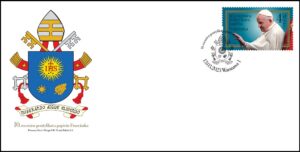
Symbolika herbu papieża Franciszka … Oprócz znaczka Poczta Polska wydała również kopertę Pierwszego Dnia Obiegu (FDC), na której umieszczono herb papieża Franciszka. W tle ciemnoniebieskiej tarczy znajdują się symbole godności papieskiej. W górnej części tarczy mieści się emblemat Towarzystwa Jezusowego – zakonu, z którego wywodzi się Papież. Na dole widnieje gwiazda mająca symbolizować Maryję Pannę, Matkę Chrystusa i Kościoła. Obok gwiazdy umieszczono kwiat nardu, którego gałązka w tradycji ikonograficznej przedstawiana jest jako atrybut św. Józefa, patrona Kościoła powszechnego. Nad tarczą herbową znajduje się tiara papieska z trzema poziomymi złotymi pasami oznaczającymi rządzenie, rozstrzyganie i nauczanie. Pod tarczą umieszczono dewizę „Miserando atque eligendo” nawiązującą do biblijnego opisu powołania celnika Lewiego. Zgodnie z zasadami heraldycznymi, za tarczą znajdują się klucze Piotrowe oznaczające sukcesję apostolską oraz pełnię władzy biskupa Rzymu. Na kopercie FDC zamieszczono również datownik z papieskim herbem, nazwą i datą emisji: „10. rocznica pontyfikatu papieża Franciszka”.
Historyczne emisje Poczty Polskiej z wizerunkiem papieża Franciszka … Pierwszy znaczek z wizerunkiem papieża Franciszka został wprowadzony do obiegu w 2016 roku. Ukazał się w kilku formach wydawniczych, na których przedstawiono papieża Franciszka pozdrawiającego grupę młodych ludzi.
Znaczki z 2016 roku to wspólna emisja Polski i Watykanu mająca uwiecznić Światowe Dni Młodzieży w Krakowie, podczas których Ojciec Święty zaszczycił wszystkich zgromadzonych swoją obecnością. Wraz ze znaczkami wydano również rarytas filatelistyczny w postaci czarnodruku.
W 2016 roku Poczta Polska wydała również kartkę z nadrukowanym znakiem opłaty pocztowej poświęconą krótkiej wizycie papieża Franciszka na Jasnej Górze u naszej Czarnej Madonny, którą darzy On szczególną miłością. Udał się tam w drodze powrotnej do Rzymu ze Światowych Dni Młodzieży.

Spiżarnia Caritas
www.poczta-polska.pl
W dniu 15 marca 2023 roku został wprowadzony do obiegu znaczek pocztowy o wartości 0,30 zł emisji “Spiżarnia Caritas”. Na znaczku przedstawiono produkty spożywcze, ułożone w kształt serca, okalające tytuł emisji a zarazem programu społecznego Caritas Polska Spiżarnia Caritas. Poniżej logotyp programu. W tle – polskie barwy narodowe. Emisji towarzyszy koperta FDC, na której umieszczono bochen chleba. W grafice datownika – logotyp programu Spiżarnia Caritas – dwie ryby i chleb. Znaczki wydrukowano techniką rotograwiurową, na papierze fluorescencyjnym, w formacie 31,25 x 25,5 mm, w nakładzie3 000 000 sztuk. Arkusz sprzedażny zawiera 100 sztuk znaczków. Z tej okazji została wydana koperta FDC. Autor projektu: Jarosław Ochendzan.
Poczta Polska wsparła program pomocy żywnościowej „Spiżarnia Caritas”. Owocem współpracy z organizacją dobroczynną jest emisja znaczka pocztowego, promującego ideę przekazywania pełnowartościowej żywności wycofanej ze sprzedaży i jej dystrybucji osobom potrzebującym.
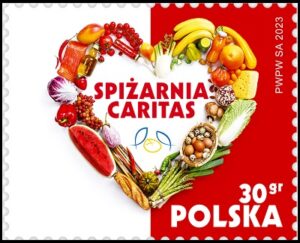
Jarosław Ochendzan, autor projektu znaczka pocztowego, nadał narodowego charakteru walorowi, wprowadzając w jego tło biało-czerwone barwy mające symbolizować ogólnopolski charakter inicjatywy organizowanej przez Caritas w Polsce. To największa charytatywna instytucja polskiego Kościoła katolickiego, prowadząca działania na całym świecie. Pierwszy plan znaczka przedstawia artykuły spożywcze ułożone w kształcie serca. Koncept grafiki podkreśla istotny wydźwięk inicjatywy, którym jest społeczna solidarność. Do obiegu wprowadzono również limitowaną kopertę Pierwszego Dnia Obiegu (FDC) z fotografią bochenka chleba, będącego znakiem pożywienia, dostatku i pomyślności oraz datownik okolicznościowy zawierający logotyp „Spiżarni Caritas”.
– Poczta, poprzez swoją działalność filatelistyczną, dysponuje możliwością promowania wartościowych akcji społecznych, także tych ukierunkowanych na pomoc ludziom ubogim i potrzebującym. Współtworzymy społeczeństwo, w którym żyjemy i pragniemy czynić je lepszym dla wszystkich. Ten cel Caritas realizuje konsekwentnie przy wsparciu tysięcy wolontariuszy i ludzi dobrej woli. Jestem dumny, że naszym najnowszym znaczkiem wspieramy szlachetną ideę, zgodną w wartościami i misją Poczty – podkreślił Wiesław Włodek, wiceprezes Poczty Polskiej.
Idea programu „Spiżarnia Caritas” … W program „Spiżarnia Caritas” są zaangażowane setki sklepów i wolontariuszy w całej Polsce. Już od sześciu lat wolontariusze tej organizacji odbierają ze sklepów, hurtowni i magazynów artykuły spożywcze o krótkim terminie ważności, ale bardzo dobrej jakości – mięso, ryby, nabiał, pieczywo, warzywa, owoce. Potem przygotowują z nich paczki żywnościowe dla potrzebujących albo przekazują produkty do jadłodajni, punktów wydawania żywności i ośrodków pomocy, gdzie zostają przygotowane posiłki.
Program Spiżarnia Caritas realizuje 47 Caritas diecezjalnych i organizacji pożytku publicznego, w których działa 1600 wolontariuszy. Nawiązano współpracę z największymi sieciami handlowymi, które w 2021 roku przekazały w sumie ponad 7 tys. ton żywności o wartości ponad 88 mln zł. Cykliczne wsparcie żywnościowe w postaci paczek i posiłków uzyskało ponad 60 tys. osób.
– Nadal około 1,6 mln Polaków żyje w skrajnym ubóstwie. Jednocześnie przeciętna 4-osobowa rodzina w Polsce wyrzuca każdego roku jedzenie o wartości ok. 2500 zł – mówi ks. dr Marcin Iżycki, dyrektor Caritas Polska. W programie Spiżarnia Caritas staramy się łączyć troskę o potrzebujących, zarówno naszych sąsiadów, jak i osoby, których na co dzień nie dostrzegamy, z ochroną środowiska. Dzięki znaczkowi Poczty Polskiej program Spiżarnia Caritas może dotrzeć do jeszcze szerszego grona odbiorców, zachęcając do pomocy ubogim i umiarkowanych zakupów – dodaje ks. dr Marcin Iżycki.
Tegoroczny znaczek pocztowy poświęcony Caritas Polska to nie jedyna emisja filatelistyczna promująca prospołeczne inicjatywy katolickiej organizacji charytatywnej. W 2021 roku Poczta Polska upamiętniła 30-lecie organizacji, wprowadzając do obiegu okolicznościowy znaczek przygotowany przez projektanta Jacka Konarzewskiego.

75 lat Śląskiego Uniwersytetu Medycznego w Katowicach
www.poczta-polska.pl
W dniu 20 marca 2023 r. została wprowadzona do obiegu kartka pocztowa z nadrukowanym znakiem opłaty pocztowej, emisji: “75 lat Śląskiego Uniwersytetu Medycznego w Katowicach”. Wartość nominalna znaku opłaty pocztowej z oznaczeniem literowym A odpowiada wartości nominalnej znaczka pocztowego używanego do uiszczenia opłaty za ekonomiczną przesyłkę listową nierejestrowaną, w tym kartkę pocztową, w obrocie krajowym, w formacie S o masie do 500 g. W prawym górnym rogu strony adresowej kartki nadrukowano znak opłaty pocztowej, na którym umieszczono zdjęcia trzech rektorów Śląskiego Uniwersytetu Medycznego w Katowicach: prof. Zbigniewa Hermana, prof. Franciszka Kokota oraz prof. Zbigniewa Religę, a jego górnej części napis: POLSKA i oznaczenie wartości: A. W części ilustracyjnej kartki przedstawiono zdjęcie budynku w Zabrzu – Rokitnicy, przedstawiające pierwszą siedzibę obecnego Śląskiego Uniwersytetu Medycznego w Katowicach oraz napis: 75 lat Śląskiego Uniwersytetu Medycznego w Katowicach. Poczta Polska S.A. prowadziła wszystkie ustalenia związane z wydaniem kartki ze Śląskim Uniwersytetem Medycznym w Katowicach. Kartkę o wymiarach 148 x 105 mm wydrukowano jednostronnie, techniką offsetową, na kartonie białym, w nakładzie 5000 sztuk. Autor projektu kartki: Jan Konarzewski.
Zbigniew Herman, Franciszek Kokot i Zbigniew Religa to trzy wybitne postacie świata medycyny, których wizerunki uhonorowano na najnowszej karcie z nadrukowanym znakiem opłaty pocztowej. Wyjątkowy walor filatelistyczny powstał w ramach 75. rocznicy Śląskiego Uniwersytetu Medycznego. Wydana przez Pocztę Polską kartka z nadrukowanym znakiem opłaty pocztowej przypomina o latach licznych sukcesów Śląskiego Uniwersytetu Medycznego w Katowicach. To filatelistyczne ukoronowanie osiągnięć oraz ogromu pracy, jaki wkładali w swoją aktywność naukową wybitni profesorowie, stanowiący obecnie wzór dla współczesnego młodego pokolenia.
– Naszą okolicznościową kartką z nadrukowanym znakiem opłaty pocztowej pragniemy docenić dorobek i potencjał naukowy, honorując w projekcie waloru filatelistycznego trzech wybitnych i zasłużonych profesorów. Zbigniew Herman, Franciszek Kokot i Zbigniew Religa to postacie, które na stałe zagościły w panteonie najwybitniejszych ludzi związanych z naukami medycznymi – zaznaczył Wiesław Włodek, wiceprezes Poczty Polskiej.
W prawym górnym rogu strony adresowej kartki umieszczono zdjęcia trzech rektorów Śląskiego Uniwersytetu Medycznego w Katowicach: prof. Zbigniewa Hermana, prof. Franciszka Kokota oraz prof. Zbigniewa Religę. W części ilustracyjnej kartki przedstawiono zdjęcie budynku w Zabrzu – Rokitnicy, pierwszą siedzibą obecnego Śląskiego Uniwersytetu Medycznego w Katowicach.

Dokonania trzech wybitnych profesorów … Trzech wybitnych i zasłużonych profesorów, pełniących wieloletnią funkcję Rektora Śląskiego Uniwersytetu Medycznego w Katowicach, dokonało wielu przełomowych odkryć dla świata medycyny. Śp. Profesor Zbigniew Herman w uznaniu swoich zasług został odznaczony Krzyżem Oficerskim oraz Krzyżem Komandorskim z Gwiazdą Orderu Odrodzenia Polski. Był światowym autorytetem w zakresie działania leków psychotropowych. Jego Badania przyniosły pierwsze dowody potwierdzające związki ośrodkowego układu nerwowego z układem immunologicznym. Śp. Profesor nauk medycznych Franciszek Kokot znany jest na świecie ze swoich osiągnięć w dziedzinie interny, endokrynologii i nefrologii. Śp. Profesor Zbigniew Religa to postać, której nie trzeba w zasadzie przedstawiać. Wybitny kardiochirurg, Kawaler i członek Kapituły Orderu Orła Białego. Późniejsze wielkie osiągnięcia Zbigniewa Religi pozostawały nieco w cieniu przeprowadzonego przez niego pierwszego w Polsce zabiegu transplantacji serca. Profesor Religa pozostał pionierem polskiej kardiochirurgii, wykonując po raz pierwszy w kraju przeszczep płuc i serca oraz przeprowadził zabiegi leczenia przewlekłej zatorowości płucnej. W 1988 r. z jego inicjatywy powstała Pracownia Sztucznego Serca Śląskiej Akademii Medycznej. Trzy lata później stworzył prototyp sztucznego serca i zastawki biologicznej.
Pierwszy walor filatelistyczny dedykowany jubileuszowi polskiej uczelni … W 2021 r. Poczta Polska uczciła okolicznościowym znaczkiem 100. rocznicę utworzenia Uniwersytetu Poznańskiego. Znaczek pocztowy przedstawiał portret prof. dr. Heliodora Święcickiego – jednego z założycieli i pierwszego rektora Wszechnicy Piastowskiej w Poznaniu, jak pierwotnie nazywano Uniwersytet Poznański. Autor znaczka Bożydar Grozdew wykorzystał do projektu fragment obrazu Józefa Bronisława Czarneckiego. Wraz ze znaczkiem ukazała się koperta FDC w limitowanej wersji. Przedstawiono na niej fasadę budynku Collegium Minus Uniwersytetu Poznańskiego.

Polacy ratujący Żydów
www.poczta-polska.pl
24 marca 2023 r. Poczta Polska wprowadziła do obiegu znaczek pocztowy o wartości 3,90 zł emisji “Polacy ratujący Żydów”, upamiętniający tragiczną historię rodziny Baranków. Nowe wydawnictwo filatelistyczne wpisuje się w serię dokumentującą losy Bohaterów zamordowanych przez Niemców za pomoc Żydom. Twórca projektu znaczka pocztowego Jarosław Ochendzan przedstawił na grafice waloru ślubne zdjęcie z wizerunkami Wincentego i Łucji Baranek. W kompozycji nowego waloru pojawiły się ponadto fotografie portretów synów bohaterskiej familii Henryka Mariana i Tadeusza Stanisława. Obok przedstawione zostało również zdjęcie należące do macochy Wincentego Baranka. Znaczek wydrukowano techniką rotograwiurą, na papierze fluorescencyjnym, w formacie znaczka 31,25 x 39,5 mm, w nakładzie 100.000 sztuk. Arkusz sprzedażny zawiera 50 znaczków.
Wraz ze znaczkiem Poczta Polska wprowadziła do obiegu kopertę pierwszego dnia obiegu (FDC), przedstawiającą dom rodziny Baranków, znajdujący się we wsi Siedliska pod Miechowem. To właśnie na terenie tej posesji doszło do bestialskiej zbrodni – zamordowania Polaków i czterech ukrywanych przez nich Żydów o nazwisku Gottfried. Wraz ze zdjęciem domu Baranków na kopercie widnieje również Menora, jeden z najbardziej znanych i najstarszych symboli judaizmu. Uzupełnieniem waloru jest datownik, prezentujący dłonie trzymające Gwiazdę Dawida.
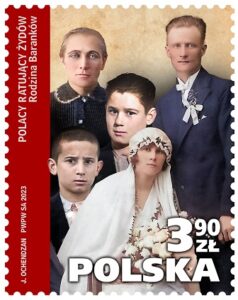
Lokalni bohaterowie z Miechowa … 16 marca 1942 r. na terenie Generalnego Gubernatorstwa Niemcy rozpoczęły realizację zbrodniczej operacji o kryptonimie Aktion „Reinhardt”, mającej na celu zagładę ludności żydowskiej. Rok później, 15 marca 1943 r., w Siedliskach koło Miechowa za ukrywanie kilku mężczyzn z rodziny Gottfriedów niemieccy funkcjonariusze zamordowali Wincentego i Łucję Baranków wraz synami. Zabita została również mieszkająca w tym samym domu Katarzyna Baranek, macocha Wincentego, a także czterej z pięciu ukrywanych Żydów.
Narodowe odznaczenia przyznane rodzinie Baranków … 3 lipca 2012 r. Wincenty Baranek, Łucja Baranek i Katarzyna Baranek zostali pośmiertnie odznaczeni medalem „Sprawiedliwy wśród Narodów Świata” podczas ceremonii odbywającej się w Muzeum Żydów Polskich. 24 grudnia 2012 r. tym samym odznaczeniem uhonorowano Henryka i Tadeusza Baranków. Postanowieniem prezydenta RP Bronisława Komorowskiego z dnia 8 listopada 2013 r. Wincenty Baranek, Łucja Baranek i Katarzyna Baranek z d. Kopeć, zostali pośmiertnie odznaczeni Krzyżem Komandorskim Orderu Odrodzenia Polski. Polacy to najliczniejsza grupa uhonorowanych medalem „Sprawiedliwy wśród Narodów Świata”, nadawanym przez izraelski instytut Yad Vashem. Wyróżniono nim około 7 tysięcy polskich rodzin, tj. Ulmów, Kowalskich, Maciejewskich, Brogowskich czy Czarnych, których członkowie narażali lub poświęcili życie, pomagając żydowskim sąsiadom.
Poczta Polska honoruje historie Polaków ratujących Żydów … W 2018 r. Poczta Polska wprowadziła do obiegu pierwszy znaczek przypominający historię zamordowanej rodziny Ulmów, która podczas okupacji dała schronienie ośmiorgu Żydom. W tym samym roku Spółka wydała również kartkę upamiętniającą postać siostry Matyldy Getter. W 2019 r. w ręce klientów i filatelistów trafiło kolejne wydawnictwo serii. Prezentowało Edwarda Raczyńskiego – ówczesnego ministra sprawa zagranicznych Rządu RP na uchodźstwie, którego nota była pierwszym oficjalnym raportem o holokauście, informującym zachodnią opinię publiczną o zbrodniach. Było to również pierwsze oficjalne wystąpienie jednego z rządów w obronie wszystkich Żydów prześladowanych przez hitlerowskie Niemcy. W 2021 r. zaprezentowano walor dedykowany wydarzeniom z Gmin Nawojowa i Kamionka Wielka w Małopolsce, gdzie członkowie rodzin: Rumin, Borek oraz Tokarz, swoją pomoc dla społeczności wyznania mojżeszowego przypłacili własnym życiem.
W 2022 r. wprowadzono do obiegu znaczek przedstawiający Bronisławę i Adama Kowalskich z dziećmi, którzy zostali bestialsko zamordowani przez niemieckich żandarmów za pomoc i ukrywanie Żydów. Oprócz znaczka wydano w limitowanej wersji kopertę FDC, czyli kopertę pierwszego dnia obiegu. Prezentuje ona zarys mapy przedstawiającej okolice Ciepielowa, Starego Ciepielowa oraz Rekówki, gdzie rozegrały się tragiczne wydarzenia. W tym samym roku Poczta Polska przygotowała również wystawę prezentującą emisje filatelistyczne poświęcone Polakom ratującym Żydów, którą można było oglądać w pięciu placówkach pocztowych: Bydgoszczy, Tarnowie, Łodzi oraz Lublinie. Wystawę przygotował Instytut Pamięci Narodowej. W 2021 r. inicjatywa ta odbywała się na pocztach głównych w Warszawie, Katowicach, Krakowie, Poznaniu oraz Gdańsku.

Sztuka sakralna
www.poczta-polska.pl
W dniu 25 marca 2023 r. została wprowadzona do obiegu kartka pocztowa z nadrukowanym znakiem opłaty pocztowej, emisji: Sztuka sakralna. Wartość nominalna znaku opłaty pocztowej z oznaczeniem literowym A odpowiada wartości nominalnej znaczka pocztowego używanego do uiszczenia opłaty za ekonomiczną przesyłkę listową nierejestrowaną, w tym kartkę pocztową, w obrocie krajowym, w formacie S.
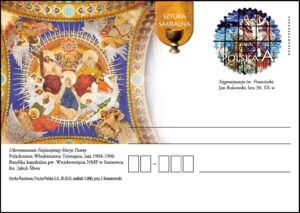
W prawym górnym rogu strony adresowej kartki nadrukowano znak opłaty pocztowej w formie koła, na którym umieszczono witraż z Bazyliki katedralnej pw. Wniębowzięcia NMP w Sosnowcu, autorstwa Jana Bukowskiego, przedstawiający scenę stygmatyzacji św. Franciszka, zaś w dolnej części napis: POLSKA i oznaczenie wartości: A. W części ilustracyjnej kartki przedstawiono fragment polichromii Włodzimierza Tetmajera z Bazyliki katedralnej pw. Wniębowzięcia NMP w Sosnowcu przedstawiający ukoronowanie Najświętszej Maryi Panny. Kartkę o wymiarach 148 x 105 mm wydrukowano jednostronnie, techniką offsetową, na kartonie białym, w nakładzie 5000 sztuk. Autor projektu kartki: Jacek Konarzewski.


Mikołaj Kopernik … Banknot kolekcjonerski NBP
www.nbp.pl
9 lutego 2023 roku Narodowy Bank Polski wprowadził do obiegu banknot kolekcjonerski o nominale 20 zł „Mikołaj Kopernik”. Jest to drugi, wyemitowany przez NBP, kolekcjonerski banknot polimerowy.

Nominał: 20 zł … Podłoże: polimerowe; Wymiary: 150 mm × 77 mm; Nakład: do 100 000 szt.; Projektant: Krystian Michalczuk. Emitent: NBP Producent: Polska Wytwórnia Papierów Wartościowych S.A. na zlecenie NBP.
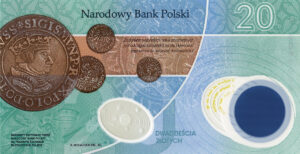
Strona przednia banknotu przedstawia najpopularniejszy (tzw. toruński) portret Mikołaja Kopernika oraz stylizowane wizerunki kwadrantu i fragmentu układu heliocentrycznego. Na stronie odwrotnej banknotu zostały zaprezentowane wizerunki historycznych monet: awers i rewers szóstaka gdańskiego, awers szóstaka elbląskiego, awers szeląga pruskiego (Toruń), a także wizerunek fragmentu układu heliocentrycznego. W tle widnieje również Zamek Kapituły Warmińskiej w Olsztynie. Fragment wizerunku układu heliocentrycznego został zaczerpnięty z rękopisu traktatu Mikołaja Kopernika O obrotach sfer niebieskich, znajdującego się w Bibliotece Jagiellońskiej (Rkp. 10000).
W 2023 r. przypadają obchody 550-lecia urodzin Mikołaja Kopernika, wybitnego astronoma, twórcy teorii heliocentrycznej, lekarza, ekonomisty – autora jednej z wersji prawa rządzącego obiegiem pieniądza (gorszy pieniądz zawsze wypiera lepszy), wiernego poddanego polskich królów – obrońcy Olsztyna przed Krzyżakami. Mikołaj Kopernik urodził się w Toruniu 19 lutego 1473 r. w rodzinie bogatego kupca Mikołaja Kopernika i Barbary z domu Watzenrode. Jego ojciec pochodził ze Śląska, a matka z patrycjuszowskiej rodziny toruńskiej. Przyszły astronom uczył się najpierw w Toruniu, potem zapewne w Chełmnie. W latach 1491–1503 studiował w Krakowie, Bolonii i Padwie. Studia zakończył uzyskaniem doktoratu z prawa kanonicznego w Ferrarze w 1503 r. W 1503 r. Kopernik powrócił do Polski i osiadł na Warmii, gdzie biskupem był jego wuj i mecenas Łukasz Watzenrode. Już wcześniej, w 1495 r. astronom został kanonikiem warmińskim. W latach 1503–1510 mieszkał przy wuju w Lidzbarku Warmińskim, a od 1510 r. w zasadzie stale przebywał we Fromborku, jedynie w latach 1519–1521 w Olsztynie.
Najważniejszym dziełem Kopernika jest praca De revolutionibus orbium coelestium (O obrotach sfer niebieskich). Przypuszcza się, że Kopernik zaczął ją pisać w 1514 r., a skończył około 1530 r. Długo zwlekał z jej wydaniem – wyszła drukiem w 1543 r. dzięki staraniom niemieckiego uczonego Jerzego Joachima Retyka. Nie jest pewne, czy autor zobaczył swoje dzieło przed śmiercią w maju 1543 r. Informacja: Prof. dr hab. Krzysztof Mikulski.

Nicolaus Copernicus … NBP collector banknote
www.nbp.pl
On 9 February 2023, Narodowy Bank Polski issued into circulation a collector banknote “Nicolaus Copernicus”, with a face value of 20 złoty. It is the second polymer collector banknote issued by NBP.

Face value: 20 zł … Material: polymer; Dimensions: 150 mm × 77 mm; Volume: up to 100,000 pcs; Designer: Krystian Michalczuk. Issuer: NBP; Manufacturer: Polish Security Printing Works (PWPW S.A.), on behalf of NBP.

The front side of the banknote features the most popular (so-called Toruń) portrait of Nicolaus Copernicus and stylised images of a quadrant and a fragment of the heliocentric system. The back side of the banknote features the images of historical coins: the obverse and reverse of the Gdańsk szóstak (six grosz), the obverse of the Elbląg szóstak (six grosz), the obverse of the Prussian (Toruń) schilling and an image of a fragment of the heliocentric system. The background also features the Castle of the Warmian Cathedral Chapter in Olsztyn. The fragment of the image of the heliocentric system was taken from the manuscript of Nicolaus Copernicus’s treatise “On the Revolutions of the Heavenly Spheres” (De revolutionibus orbium coelestium), held in the Jagiellonian Library (Manuscript 10,000).
The year 2023 will mark the 550th Anniversary of the birth of Nicolaus Copernicus, outstanding astronomer, creator of the heliocentric theory, physician, economist – author of one of the versions of the law governing the circulation of money (bad money always drives out good money), and faithful subject of Polish kings – defender of Olsztyn against the Teutonic Knights. Nicolaus Copernicus was born in Toruń on 19 February 1473 to the family of a wealthy merchant Nicolaus Copernicus and Barbara née Watzenrode. His father came from Silesia and his mother from a patrician Toruń family. The future astronomer was first educated in Toruń, then probably in Chełmno. In 1491–1503, he studied in Kraków, Bologna and Padua. He completed his studies with a doctorate in canon law in Ferrara in 1503. In 1503 Copernicus returned to Poland and settled in Warmia, where his uncle and patron Łukasz Watzenrode was bishop. Before, in 1495, the astronomer had become a canon of Warmia. From 1503 to 1510, he lived with his uncle in Lidzbark Warmiński, and from 1510 onwards he basically stayed permanently in Frombork, and only in 1519-1521 in Olsztyn.
Copernicus’s most important work is De revolutionibus orbium coelestium [On the Revolutions of the Heavenly Spheres]. Copernicus is believed to have started writing it in 1514 and to have finished it around 1530. He delayed its publication for a long time – it was published in 1543 thanks to the efforts of the German scholar Joachim Rheticus. It is uncertain whether the author saw his work before he died in May 1543. Info: Krzysztof Mikulski, PhD, DSc, Prof Tit.

Wyklęci przez komunistów żołnierze niezłomni –
Józef Kuraś „Ogień”
www.nbp.pl
Narodowy Bank Polski ma wyłączne prawo emitowania znaków pieniężnych Rzeczypospolitej Polskiej, w tym monet i banknotów kolekcjonerskich. Wszystkie monety i banknoty emitowane przez NBP są prawnym środkiem płatniczym w Polsce. Emisja wartości kolekcjonerskich stanowi okazję do upamiętniania ważnych historycznych rocznic i postaci oraz do rozwijania zainteresowań polską kulturą, nauką i tradycją. 15 marca 2023 roku Narodowy Bank Polski wprowadził do obiegu srebrną monetę o nominale 10 zł z serii „Wyklęci przez komunistów żołnierze niezłomni” – „Józef Kuraś »Ogień«”.

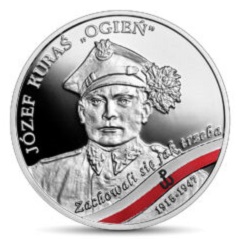
Nominał 10 zł … metal: Ag 925/1000; stempel: lustrzany, tampondruk; średnica: 32,00 mm; masa: 14,14 g; brzeg (bok): gładki; nakład: do 10 000 szt.; Projektant: Dobrochna Surajewska; Emitent: NBP; Na zlecenie NBP monety wyprodukowała Mennica Polska S.A.
Na awersie srebrnej monety przedstawiono rozerwane kraty więzienne. Na każdej polskiej monecie znajdują się: nominał, napis „Rzeczpospolita Polska”, rok emisji, wizerunek orła ustalony dla godła Rzeczypospolitej Polskiej. Na rewersie monety znajdują się wizerunki: Józefa Kurasia ps. „Ogień”, wstęgi o barwach Rzeczypospolitej Polskiej z symbolem Polski Walczącej, napis „Zachowali się jak trzeba” oraz daty urodzin i śmierci „Ognia”: 1915–1947.
Józef Kuraś („Ogień”, „Orzeł”) urodził się 23 października 1915 r. w Waksmundzie koło Nowego Targu. W 1934 r. został członkiem Stronnictwa Ludowego. Powołany do wojska w 1936 r. służył w Sanoku i Słobodce koło Wilna. W czasie kampanii wrześniowej 1939 r. walczył w szeregach 1 Pułku Strzelców Podhalańskich. Po nieudanej próbie przedostania się do Francji wrócił do Waksmundu. W listopadzie 1939 r. zaangażował się w działalność konspiracyjną. Był żołnierzem Konfederacji Tatrzańskiej i Armii Krajowej, dowódcą oddziałów Ludowej Straży Bezpieczeństwa oraz oddziału egzekucyjnego Powiatowej Delegatury Rządu RP w Nowym Targu.
W czerwcu 1943 r. w odwecie za egzekucję dokonaną przez oddział Kurasia na dwóch policjantach będących agentami Gestapo Niemcy zamordowali jego żonę, dwuipółletniego syna i ojca. Ciała zamordowanych i rodzinny dom Kurasia spalono. To wówczas Józef Kuraś przyjął pseudonim „Ogień”. Na początku 1945 r. Kuraś uczestniczył w tworzeniu struktur Milicji Obywatelskiej i Urzędu Bezpieczeństwa w Nowym Targu, realizując zalecenia kierowanego przez Stanisława Mikołajczyka Stronnictwa Ludowego, dotyczące przejmowania władzy na terenach wyzwolonych przez Sowietów. Kiedy okazało się, że wizja ta jest nierealna, Kuraś utworzył zgrupowanie partyzanckie „Błyskawica”.
13 kwietnia 1945 r. przeprowadził w górach odprawę swoich byłych podkomendnych, zapowiadając walkę przeciw Związkowi Socjalistycznych Republik Radzieckich i przeciw komunistom. Toczył ją na Podhalu i w innych częściach województwa krakowskiego do 1947 r., w wielu miejscach stanowiąc w terenie realną władzę wojskową, a nawet polityczną – wobec słabości władzy komunistycznej. Oddziały „Ognia” organizowały też akcje przeciwko Słowakom opowiadającym się za przyłączeniem polskich części Spiszu i Orawy do państwa słowackiego. Zgrupowanie „Błyskawica” miało znakomicie działający wywiad i cieszyło się poparciem społeczeństwa. 21 lutego 1947 r. otoczony przez oddziały UB i Korpusu Bezpieczeństwa Wewnętrznego we wsi Ostrowsko pod Nowym Targiem mjr „Ogień” próbował popełnić samobójstwo. Ranny zmarł następnego dnia w szpitalu w Nowym Targu. Do dziś nie jest znane miejsce jego pochówku. Informacja: Tadeusz Płużański.

The Enduring Soldiers Accursed by the Communists –
Józef Kuraś “Ogień”
www.nbp.pl
Narodowy Bank Polski holds the exclusive right to issue the currency of the Republic of Poland, including collector coins and banknotes. All coins and banknotes issued by NBP are legal tender in Poland. Issuing collector items is an occasion to commemorate important historic figures and anniversaries as well as to develop the interest of the public in Polish culture, science, and tradition. All Polish collector coins feature: face value, inscription: Rzeczpospolita Polska, year of issue, image of the Eagle established as the state emblem of the Republic of Poland. On 15 March 2023, Narodowy Bank Polski issued into circulation a silver coin of the series “The Enduring Soldiers Accursed by the Communists” – Józef Kuraś “Ogień”, with a face value of 10 złoty.


Face value: 10 zł … Metal: Ag 925/1000; Finish: proof, pad printing; Diameter: 32.00 mm; Weight: 14.14 g; Edge (side): plain; Mintage: up to 10,000 pcs; Designer: Dobrochna Surajewska ; Issuer: NBP; The coins, commissioned by NBP, were struck by Mennica Polska S.A.
The obverse of the silver coin features prison bars torn apart. The reverse of the coin carries the images of Józef Kuraś “Ogień”, a white-and-red flag with the symbol of Fighting Poland, and the inscriptions: “Zachowali się jak trzeba” (“They acted as they should”) and “1915–1947” (Ogień’s dates of birth and death).
Józef Kuraś (“Ogień”, “Orzeł”) was born on 23 October 1915 in Waksmund near Nowy Targ. In 1934, he became a member of the People’s Party (Stronnictwo Ludowe), a peasant party in Poland. Drafted into the army in 1936, he served in Sanok and Słobodka near Vilnius. During the September campaign of 1939, he fought in the ranks of the 1st Podhale Rifle Regiment, a mountain infantry unit. After an unsuccessful attempt to get through to France, he returned to Waksmund. In November 1939, he became involved in underground activities. He was a soldier of the Tatra Confederation (Konfederacja Tatrzańska) and the Home Army (Armia Krajowa), he also commanded the People’s Security Guard (Ludowa Straż Bezpieczeństwa) units and the execution squad of the county branch of the Government Delegation for Poland (the highest authority of the Polish underground state and an agency of the Polish Government in Exile) in Nowy Targ.
In June 1943, in retaliation for the execution carried out by Kuraś’s unit on two policemen who were Gestapo agents, the Germans murdered his wife, two-and-a-half-year-old son and father. The bodies of the murdered and Kuraś’s family house were burned. It was then that Józef Kuraś adopted the pseudonym “Ogień”, which means “Fire” in Polish. At the beginning of 1945, Kuraś participated in the creation of the structures of the police (the so-called Citizens’ Militia) and the secret police (Urząd Bezpieczeństwa, UB) in Nowy Targ, implementing the recommendations of the opposition party, i.e. the People’s Party led by Stanisław Mikołajczyk, for its sympathizers to take over from within the control of the state power structures established on the territories liberated by the Soviets. When this vision turned out to be unrealistic and the communists’ grip on power proved firm, Kuraś formed the “Błyskawica” partisan unit.
On 13 April 1945, he held a briefing in the mountains for his former subordinates, announcing an open fight against the Union of Soviet Socialist Republics and against the communists. He carried it out in the Podhale region and in other parts of the Kraków province until 1947, in many places becoming a real local military power and even a political power to contend with due to the initial weakness and porousness of the communist rule. The units led by “Ogień” also organised actions against the Slovaks, who were in favour of the annexation of the Polish parts of Spisz and Orawa by the Slovak state. The “Błyskawica” group had an excellent intelligence service and enjoyed wide popular support. On 21 February 1947, major “Ogień” was finally surrounded by units of the UB and the Internal Security Corps in the village of Ostrowsko near Nowy Targ and attempted to commit suicide. The next day he died from his wounds in a hospital in Nowy Targ. To this day, his burial place is unknown. Info: Tadeusz Płużański.


Bluenose, 100th Anniversary: Souvenir sheet
www.canadapost.ca
Mark the centennial of the launch of the most recognized sailing vessel in Canadian history with this souvenir sheet that features both PermanentTM domestic rate stamps (two designs se-tenant) from Canada Post’s Bluenose, 100th Anniversary issue. The first image portrays Bluenose on a fishing expedition; the second image commemorates Bluenose competing in its debut race in 1921.
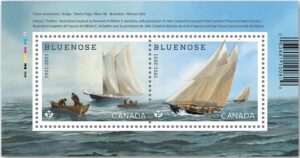
Designed by William J. Roué of Dartmouth, Nova Scotia, and built in Lunenburg’s Smith & Rhuland Shipyard, Bluenose was launched on March 26, 1921 and helmed by Captain Angus J. Walters. It outpaced all other competitors in the North Atlantic to win the International Fishermen’s Trophy. It remained undefeated in four subsequent Trophy series over the next 17 years – 1922, 1923, 1931 and 1938 – earning the schooner the nickname the “Queen of the North Atlantic”. Sold to work as a freighter in the Caribbean, Bluenose struck a reef and sank off the coast of Haiti in 1946.
Bluenose has famously adorned the 10-cent coin almost exclusively since 1937, is featured on Nova Scotia’s current licence plate and has been immortalized in song by folk legend Stan Rogers. The famous schooner was also painted by east-coast marine artist William E. de Garthe (1907-83) whose Bluenose and Three Dories inspired the stamp illustration of Bluenose fishing featured on this souvenir sheet. Stamp Value: Permanent™ domestic rate … Stamp Designer: Dennis Page and Oliver Hill; Quantity Produced 70,000; Issue Date: June 29, 2021.

Animal Mothers and Babies:
Permanent™ domestic rate stamps
www.canadapost.ca
Celebrate the bond between animal mothers and their babies by taking home this beautiful booklet of 6 Permanent™ domestic rate stamps from the Animal Mothers and Babies stamp issue.
About the issue … Parenting in the wild is a tough job. Some animal mothers and fathers are always on duty – feeding their babies and protecting them from predators. In their aquatic habitats, where threats can come from both above and below, the sea otter (Enhydra lutris) and the red-necked grebe (Podiceps grisegena) serve as floating havens for their vulnerable offspring. Canada Post has a longstanding tradition of showcasing Canadian wildlife and using stamps to raise awareness of the impacts of human activity on animal populations. These two species face many threats posed by humans.

About the sea otter … Mature female sea otters give birth to a single pup every year for life. The sole caregiver, mother otters float on their backs to feed, groom and cradle their young. The species, once hunted for its luxurious fur, was extirpated from British Columbia but has made a gradual comeback since being reintroduced. It is currently listed as being of special concern in Canada.
About the red-necked grebe … Red-necked grebes take turns incubating their eggs and carrying the chicks, which climb onto their parents’ backs immediately after hatching. The monogamous pairs sometimes divide the brood to share feeding responsibilities. Found across most of Canada, these water birds winter off the Pacific and Atlantic coasts. Like sea otters, they face threats such as oil spills, as well as loss of their freshwater nesting habitat from other human disturbances.
Designer: Meredith MacKinlay, of Halifax-based Egg Design, chose embroidery as the basis for the design because of the association that fabrics have with feelings of hominess and familial love – and because needlework lends texture to the animals’ fur and feathers. Temagami Anishinaabe artist Caroline Brown created the images on the stamps using a combination of traditional embroidery and beadwork. Stamp Value: Permanent™ domestic rate; Quantity Produced: 200,000; Issue Date: April 18, 2023.
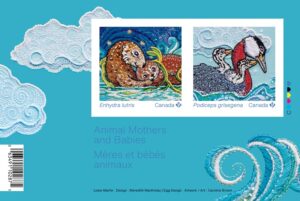
Souvenir sheet … Designer: Meredith MacKinlay, of Halifax-based Egg Design, chose embroidery as the basis for the design because of the association that fabrics have with feelings of homeyness and familial love – and because needlework lends texture to the animals’ fur and feathers. Temagami Anishinaabe artist Caroline Brown created the images on the stamps using a combination of traditional embroidery and beadwork. Quantity Produced 7,000; Issue Date: April 18, 2023.
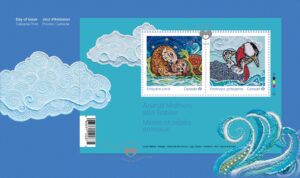
Souvenir sheet Official First Day Cover … Celebrate the bond between animal mothers and their babies by taking home this beautiful souvenir sheet Official First Day Cover (OFDC) from the Animal Mothers and Babies stamp issue.
OFDC … Designer Meredith MacKinlay, of Halifax-based Egg Design, chose embroidery as the basis for the design because of the association that fabrics have with feelings of homeyness and familial love – and because needlework lends texture to the animals’ fur and feathers. Temagami Anishinaabe artist Caroline Brown created the images on the stamps using a combination of traditional embroidery and beadwork.
The cancellation date of April 18 was chosen in advance of Earth Day (April 22), when Canadians are encouraged to take positive action on environmental issues, including the impacts of climate change and pollution on species such as those featured on these stamps. Because they celebrate the bond between animal mothers and their young, the stamps were also issued several weeks ahead of Mother’s Day. The cancellation location is Vancouver, since British Columbia is home to Canada’s only remaining sea otter population. Cancellation Site: Vancouver BC; Stamp Designer: Meredith MacKinlay Egg Design; Stamp Value: Permanent™ domestic rate; Quantity Produced: 50,000; Issue Date April 18, 2023.

2023 … $20 Pure Silver Coin –
Commemorating Black History:
No. 2 Construction Battalion
www.mint.ca www.canadapost.ca
Brought to light: No. 2 Construction Battalion and its contributions to Canada’s efforts in the First World War… They served with distinction, and they were willing to risk their lives to preserve the very rights and freedoms that weren’t always afforded to them before, during and after the First World War. From the unit’s formation in 1916 until its disbandment in 1920, the members of No. 2 Construction Battalion—the largest all-Black battalion-sized unit in Canadian military history—persevered in the face of anti-Black racism to provide vital support to Canada’s war effort, by assisting Canadian Forestry Corps (CFC) lumber operations in France. This 99.99% pure silver coin honours the brave men who served in No. 2 Construction Battalion and brings to light their often-overlooked contribution in the First World War. Despite racial prejudice, the members of No. 2 Construction Battalion persevered in their determination to serve, and a century later, their legacy remains an inspiration.
Pride and Perseverance … The 2023 instalment brings to light the often-overlooked story of No. 2 Construction Battalion and its contributions to Canada’s war efforts in the First World War. The focus is on the history … To keep the focus on those who persevered in their efforts to serve, and as an expression of a nation’s gratitude for their service and sacrifices, the only word engraved on the coin’s reverse is “CANADA”. Maple leaf pattern … Like the 2021 The Black Loyalist coin and 2022’s The Underground Railroad, your 2023 coin features a symbol of Canada on its obverse, where the repeating maple leaf fills the field.

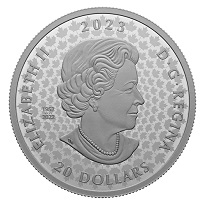
Face value: 20 dollars … Composition: 99.99% pure silver;
Mintage: 5,500; Finish: Proof; Weight: 31.39 g;
Diameter: 38 mm; Edge: serrated; Artist:
Kwame Delfish (reverse), Susanna Blunt (obverse).
Packaging: Black clamshell with black beauty box.
DID YOU KNOW? … *** No. 2 Construction Battalion recruited men from all over Canada. Many of its members were from Nova Scotia, others hailed from the United States and the British West Indies. All but one of the unit’s officers were white: its chaplain, Rev. Dr. W. Andrew White, held the rank of captain and was one of the few Black officers in the Canadian military during the war. *** Not all Black Canadians were turned away from recruiting offices during the First World War. No. 2 Construction Battalion (also known as the Black Battalion) was the largest of two all-Black units of the Canadian Expeditionary Force (CEF), other Black Canadians in smaller numbers served in other units. Black Canadians also participated in all of Canada’s major battles in the First World War, including Ypres, Vimy Ridge, Hill 70, Passchendaele and the 100 Days Campaign. *** On July 9, 2022, the Government of Canada issued a formal apology for the racism and discrimination endured by members of No. 2 Construction Battalion.
Designed by Canadian artist Kwame Delfish, your coin’s reverse honours the legacy of No. 2 Construction Battalion, Canadian Expeditionary Force (CEF), and its contributions to Canada’s war efforts during the First World War. At the centre of the design is a member of Canada’s largest all-Black battalion-sized military unit, and an enlarged view of No. 2 Construction Battalion cap badge appears to the left of him. Behind the Black soldier and to the right, members of the battalion are shown marching in a parade prior to deployment in March 1917. On the other side, the landscape represents the Jura region of France, where the battalion assisted with logging and lumber operations, and with building a railroad that, on this coin, symbolizes the journey and hardships endured by Black Canadian soldiers more than a century ago. The obverse features a maple leaf pattern and the effigy of Queen Elizabeth II by Susanna Blunt. The obverse also bears a special marking that includes four pearls symbolizing the four effigies that have graced Canadian coins and the double date of her reign.
Resilience and the determination to serve: Canada’s No. 2 Construction Battalion … During the first two years of the First World War, hundreds of Black Canadians eagerly attempted to enlist with the Canadian Expeditionary Force, but most were turned away because they were Black. Still, Black Canadians and white supporters pressed officials to allow Black enlistment. When Britain requested more labour units from Canada in 1916, the decision was made to establish a segregated labour battalion.
No. 2 Construction Battalion was formed on July 5, 1916, and was initially headquartered in Pictou, N.S. before moving to Truro, N.S. On March 28, 1917, the battalion sailed from Halifax aboard the SS Southland bound for Liverpool, England. No. 2 Construction Battalion arrived on April 7, 1917. At this time, the unit was reorganized as a labour company and renamed No. 2 Canadian Construction Company because it did not have enough men to be considered a battalion. On May 17, the unit was deployed to France’s mountainous Jura Department, where the men assisted the Canadian Forestry Corps with lumber and logging operations, transportation and railroad construction, water and power supply, and road maintenance.
While a small number of the soldiers of the battalion saw combat while serving in other units, the unit as a whole did not. Nevertheless, the battalion’s contributions to combat operations—and to the proud tradition of military service by Black Canadians—cannot be understated. In January 1919, most of the men of No. 2 Construction Battalion returned to Canada, and the battalion was officially disbanded in September 1920.
Kwame Delfish, Artist … This coin pays homage to not only the Black men who were originally recruited for No. 2 Construction Battalion, but to all those who were declined an opportunity to enlist in the military because of their race. While some men were successful in their military pursuits, it didn’t come without fight. As a result of the racism they endured, most would not be allowed to face combat alongside their fellow countrymen. The desire to fight for their country, regardless, demonstrates the bravery, selflessness and honour of No. 2 Construction Battalion. The existence and accomplishments of these men is another part of Canadian history that is to be acknowledged, celebrated and honoured—forever. I hope I was able to capture these honourable men in a way that represents their strength and resiliency, while also raising awareness about the critical role that No. 2 Construction Battalion had in the Canadian armed forces.

2022 … $175 Fine Silver Coin –
From the R&D Lab: Birds in Shadow Box
www.mint.ca
The shadow box is a timeless artform, one that draws you in by layering shapes to create a beautiful and familiar scene—like the one featured on this extraordinary collectible. Building on the multi layered concept introduced in 2019, the latest minting innovation from our R&D Lab is a prototype shadow box coin that pushes the boundaries of dimensional engraving even further. The coin’s reverse takes the 2019 Birds in the Backyard design and breaks it down into four distinct layers of art. By spacing out and superimposing these layers, the arrangement forms a richer, more complex scene with unparalleled depth, detail and realism, made possible by our R&D researchers. From the R&D Lab comes another exciting world first: a shadow box coin. After a robust research and development process that began before 2022, we are pleased to share this amazing collectible with you. The 2022-dated coin features the obverse with the effigy of the late Queen Elizabeth II by Susanna Blunt that has appeared on our coins from 2003 to 2022.
Outstanding depth and detail … This coin requires multiple viewings to fully appreciate all the details! The layers have been spaced out to create a floating image effect, and some of the overlapping portions obscure details that are only visible when the coin is viewed from a different angle. Exclusive packaging … Your prototype shadow box coin comes packaged in an exclusive R&D Lab wooden box with a special certificate that explains the technology.
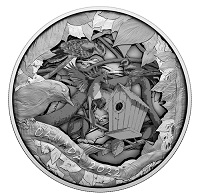
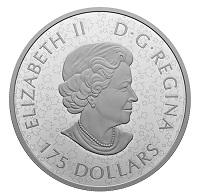
Face value: 175 dollars … Composition: 99.99% pure silver,
Mintage: 252; Finish: Proof; Weight: 711 g;
Diameter: 102 mm; Edge: serrated; Artist:
Neil Hamelin (reverse), Susanna Blunt (obverse).
Packaging: Wood case with black beauty box.
Your prototype coin’s reverse features a ground breaking shadow box concept that separates Neil Hamelin’s 2019 Birds in the Backyard design into four distinct layers of art. The bottom layer features the engraved leaves and branches of a catalpa (Catalpa speciosa) tree. The two middle layers feature three birds on the upper layer, a nest box and branches on the lower one—are superimposed to create a floating image effect. The top layer consists of a blue jay and leaves that frame your view of this multidimensional scene. The obverse features a laser-frosted maple leaf background pattern and the effigy of Her Majesty Queen Elizabeth II by Susanna Blunt.
Yiyi Yang, Ph.D, P.Eng, Research Engineer, Research & Development … The concept of a multi layered coin was first realized in our Multi layered Polar Bear coin, when we created a bi-layered coin with engraving on the inside surface; this time, we took the technology a step further by using a much larger canvas and additional layers and multiple dimensions of engraving details and features. Each layer is distinctly separate, floating above and casting shadows on the next; together, these produce a shadow box effect that emphasizes the different depths of the design elements. In addition to the design complexity, a key engineering challenge was to create enough depth inside the coin to accommodate these extra layers and spacing, without increasing the overall thickness. We were able to achieve this by building upon the knowledge we had gained from developing multiple high-relief and 3D coins.
Eric Boyer, 3D Artist and Engraver … This required a lot more effort than a typical coin of this size, and there was no room for error when producing the master tooling that ensured all four pieces would come together with complete precision. It was an exciting new canvas to sculpt on, and through this innovative approach, we were able to produce a piece with profound depth, one that really engages the viewer’s eye and invites them to explore all the layers of detail within the tree canopy.

2023 … Birthday Five-Coin Gift Card Set
www.mint.ca www.canadapost.ca
It’s unique, it’s affordable, and most of all, it’s fun! A combination gift and greeting card, the 2023 Birthday Gift Card Set is the perfect birthday present for someone special. It features five 2023-dated Canadian non-circulation coins, including a specially struck $1 birthday coin that invites the recipient to let loose their inner party moose! This year, send them a uniquely Canadian birthday greeting.
As we focus our attention on commemorating the reign of Queen Elizabeth II (1952-2022), the Mint will not be issuing any 2023-dated Canadian circulation coins featuring both the traditional reverse designs and an obverse featuring Queen Elizabeth II. Instead, we are offering a collector’s edition of these annual issues that have been struck in limited numbers. These are non-circulation coins, meaning they are legal tender but not intended for general circulation. The obverse also bears a special marking that includes four pearls symbolizing the four effigies that have graced Canadian coins and the double date of her reign.
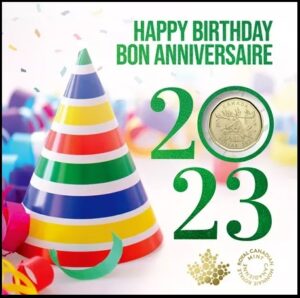
A set exclusive … Instead of a classic Loonie, the $1 non-circulation coin in this set features a fun moose that is ready to get the party started! The coin is a set exclusive—it was specially struck for the 2023 Birthday Gift Set and is not available on its own. Special obverse … The obverse of the five non-circulation coins features a marking that includes four pearls symbolizing the four effigies of Queen Elizabeth II that have graced Canadian coins and the double date of her II reign. A birthday tradition … A great gift option for all ages. And if you’ve ever scrambled for a last-minute greeting card or gift, buy an extra set (or two) and set them aside—with a little advance planning, you could have birthdays covered for the whole year!
The Birthday Gift Card Set’s exclusive $1 non-circulation coin features a reverse design by Canadian artist Steve Hepburn. With a maple leaf party hat on its head, and streamers decorating its antlers, a moose is putting the final touches on some birthday gifts. The obverse features the effigy of Queen Elizabeth II by Susanna Blunt. The obverse also bears a special marking that includes four pearls symbolizing the four effigies that have graced Canadian coins and the double date of her reign.

2023 … $50 Pure Silver Coin –
Maple Leaves in Motion
www.mint.ca
Celebrate the SML’s 35-year history with this 5 oz. pulsating UHR tribute… The most widely recognized symbol of Canada, the maple leaf continues to be a powerful representation of our proudest achievements and key milestones. On this 5 oz. fine silver coin, three maple leaves—one for each decade of the Silver Maple Leaf’s (SML) 35-year reign as one of the most sought-after bullion coins—have been rendered in Ultra High Relief (UHR). The extra relief height adds outstanding depth to the design and sends the sculpted leaves soaring above the background pattern, which dances and pulsates with pride whenever it catches the light. Pulsating with pride for Canada’s SML: See how these UHR maple leaves “pop” against a background that dances in the light.

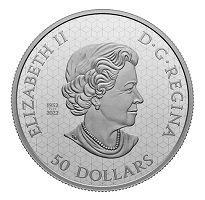
Face value: 50 dollars … Composition: 99.99% pure silver,
with ultra high relief and pulsating technology;
Mintage: 2,000; Finish: Proof; Weight: 141.75 g;
Diameter: 65.25 mm; Edge: serrated; Artist:
Nathalie Lagacé (reverse), Susanna Blunt (obverse).
DID YOU KNOW? … The Silver Maple Leaf (SML) bullion coin is minted in 1 oz. of 99.99% pure (.9999 fine) silver, which makes it one of the world’s purest silver coins. Unchanged since the first SML was issued in 1988, the bullion coin’s signature leaf comes from the sugar maple (Acer saccharum) tree, one of 10 maple species native to Canada and the one highlighted on this 5 oz. numismatic tribute.
Designed by Canadian artist Nathalie Lagacé, your coin’s reverse features a finely detailed arrangement of three sugar maple (Acer saccharum) leaves engraved in Ultra High Relief (UHR) and backed by a pulsating pattern. The reverse is double dated (“1988-2023”) to commemorate the 35ᵗʰ anniversary of Canada’s Silver Maple Leaf (SML) bullion coin. A magnified view of the pulsating pattern is engraved on the coin’s (non-pulsating) obverse, which features the effigy of Queen Elizabeth II by Susanna Blunt. The obverse also bears a special marking that includes four pearls symbolizing the four effigies that have graced Canadian coins and the double date of her reign.

2023 … $50 … 5 oz. Pure Silver Coin –
Heavenly Dragon
www.mint.ca
A benevolent figure in Chinese mythology, Tianlong is the Heavenly Dragon—the divine long (dragon) of the skies—who guards the celestial dwellings of the gods. The powerful protector is a symbol of abundance, good fortune and prosperity, and these universally desired blessings are represented on this 5 oz. 99.99% pure silver coin, which features luxurious touches of gold plating that light up your view of Tianlong among the clouds. The Heavenly Dragon carries blessings and protection for every place you call home.
Silver and gold … Gold is the traditional colour of prosperity and good fortune, and on this 99.99% pure silver coin, the gold-plated design elements add an extra touch of luxury and an auspicious gleam. The dragon’s pearl … The dragon’s precious pearl is a symbol of power, infinite wisdom and spiritual energy, and a golden pearl—like the gold-plated one depicted on your coin’s reverse—is traditionally believed to bring prosperity and good fortune. Auspicious colour … Red is the colour of luck and good fortune, and your coin comes beautifully packaged in an elegant, red lacquered wood case with a red outer box.
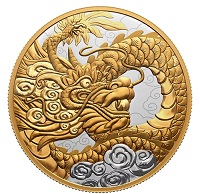
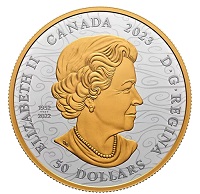
Face value: 50 dollars … Composition: 99.99% pure silver
with selective gold plating; Mintage: 2,088; Finish: Proof;
Weight: 157.6 g; Diameter: 65 mm; Edge: serrated; Artist:
Simon Ng (reverse), Susanna Blunt (obverse); Packaging:
Red lacquered wood case with custom red outer box.
DID YOU KNOW? … *** A golden dragon is traditionally a symbol of strength, power and wealth, and on your coin’s reverse, Tianlong is depicted with a pearl in its mouth—a popular Chinese motif since ancient times. Pearls continue to be associated with wisdom and wealth, spiritual energy (often in connection with the moon) and enlightenment.
Designed by Simon Ng, your coin’s reverse features a selectively gold-plated depiction of Tianlong, the benevolent Heavenly Dragon of Chinese mythology and the protector of celestial dwellings. With its feathered tail coiling gracefully behind it, Tianlong flits among the swirly clouds and holds a pearl in its mouth. The selectively gold-plated obverse features the effigy of Queen Elizabeth II by Susanna Blunt. The obverse also bears a special marking that includes four pearls symbolizing the four effigies that have graced Canadian coins and the double date of her reign.
Simon Ng, Artist … The Heavenly Dragon’s head—the focal point of this design—and its mane were created using complex shapes and forms. While the rest of the dragon’s body swirls around the head, the actual rendering extended beyond the edge of the coin to further emphasize the Heavenly Dragon’s enormous power and size. Notice the rosette-shaped clouds appearing as part of the mane, and also in the foreground and background: they’re featured throughout the design to underline the significance of the celestial dragon.

Pure Silver Proof Set – Kathleen “Kit” Coleman:
Pioneer Journalist
www.mint.ca
Pencil to paper to precious metal: The 2023 Pure Silver Proof Set honours the journey of journalism pioneer “Kit” Coleman. In a time when women journalists were limited to writing about the female perspective and women’s issues, Kathleen “Kit” Blake Coleman (1856-1915) helped pave the way for better representation in newsrooms across Canada. Known to her many readers as “Kit,” the intrepid reporter made history 125 years ago by becoming North America’s first accredited woman war correspondent. She helped establish the Canadian Women’s Press Club in 1904 and served as its first president, and later became the first syndicated woman columnist in Canada.
“Kit” Coleman is honoured on the 2023 Proof Dollar, and you’ll find an enhanced version of it in this seven-piece set. Each coin—one of every denomination, even 50 cents—has been meticulously crafted in 99.99% pure silver. But the unmistakable star of the set is “Kit” Coleman herself, whose portrait is part of the gold-plated collage on your coin’s reverse. Own a selectively gold-plated version of the 2023 Proof Dollar honouring “Kit” Coleman.
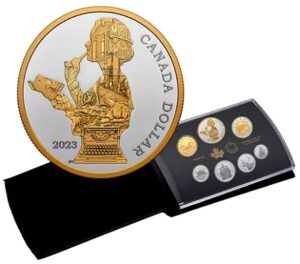
Mintage: 20,000; Artist: Proof Dollar:
Pandora Young (reverse), Susanna Blunt (obverse);
Packaging: Genuine leather book style packaging.
DID YOU KNOW? … *** Kit first joined the Toronto Daily Mailas a women’s editor in 1889 in order to support herself and her two young children. Her weekly, seven-column “Woman’s Kingdom” page featured a mix of observations and advice, thought-provoking articles and travel writings. Coleman was known to go undercover in other cities, such as London and San Francisco, in order to write about social issues and the plight of the poor. Though her travel writings were curtailed after the Mail merged with the Empire in 1895, Kit was dispatched to London in 1897 to cover Queen Victoria’s Diamond Jubilee; while there, she spent time with Sir Wilfrid Laurier, then the prime minister of Canada (and reportedly an avid reader of Coleman’s column).
*** In 1898, during the Spanish-American War, Coleman became North America’s first accredited woman war correspondent. While she was authorized to accompany American troops in Cuba, her male colleagues and the army commanders on the ground were opposed to the idea of having a woman in their midst, and they prevented her travel. Stranded in Florida, she eventually landed in Cuba in July 1898; while she had missed the main battles, her accounts of the war’s aftermath made her internationally famous.
Designed by Canadian artist Pandora Young, the Proof Dollar’s reverse features a silhouette of journalist Kathleen “Kit” Blake Coleman (1856-1915) holding an open notebook and pen. Within that silhouette are various elements that represent her life and career (from top to bottom): The Mail and Empire building in Toronto, Ont.; SS Circassian, the passenger ship that brought the Irish-born writer to Canada in 1884; a partial map of the Atlantic Ocean, to represent Coleman’s travels and dispatches; a view of Coleman writing at her desk; and a vintage typewriter that symbolizes her legacy and impact on Canadian journalism. The obverse features the effigy of Queen Elizabeth II by Susanna Blunt. The obverse also bears a special marking that includes four pearls symbolizing the four effigies that have graced Canadian coins and the double date of her reign.

Pure Gold Coin – Tall Ships: Full-Rigged Ship
www.mint.ca
Our second tall ship has all the sails and spars it could carry… With its iconic triangular staysails and square-rigged sails on all three (or more) masts, a full-rigged ship—like the one featured on the second Tall Ships pure gold coin—inspires a sense of dignified magnificence. That full complement of sails, so beautifully depicted on your coin’s reverse, makes it ideal for hauling goods and people over great distances and across deep seas, even in unpredictable conditions. The full-rigged ships of the 18th, 19th, and even 20th centuries facilitated the development of Canada—from the frigates built to defend these shores, to the cargo-carrying ships that supplied this fledgling nation.
Impeccable craftsmanship …Every Tall Ships coin is an expertly engraved and exquisitely detailed portrait of Canada’s past. These are the wooden ships that shaped the course of Canada’s history, and they served as a testament to our nation’s seafaring traditions and shipbuilding prowess. Pure gold portrait … Your low mintage (800) coin is crafted from 99.99% pure gold. Its luminous, mirror-like finish lights up the engraved art on the coin’s reverse.

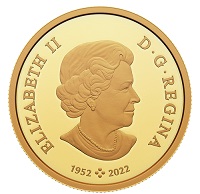
Face value: 200 dollars … Composition: 99.99% pure gold;
Mintage: 800; Finish: Proof; Weight: 15.43 g;
Diameter: 29 mm; Edge: serrated; Artist:
Neil Hamelin (reverse), Susanna Blunt (obverse);
Packaging: Black clamshell with black beauty box.
DID YOU KNOW? … ***Today, North Star of Herschel Island is Canada’s only full-rigged ship. Built in 1935 for Inuvialuit trappers, the Arctic tall ship was the largest private vessel in the Western Arctic and was used to transport pelts to market and supplies to Sachs Harbour, the ship’s home port. Following a refit, North Star was used for scientific exploration in the Arctic Ocean from 1968 to 1973, and for surveying the British Columbia-Alaska boundary. Canada’s Arctic tall ship now calls the Pacific coast home, where North Star delights and educates those who wish to learn more about the ship’s place in Canadian history. To learn more, visit www.northstarofherschelisland.ca
***Another full-rigged ship, Hector, brought the first wave of emigrants directly from Scotland to Nova Scotia in 1773, earning it the moniker “Canada’s Mayflower.” After more than 11 weeks at sea, the three-masted fluyt (a Dutch-designed, square-rigged cargo vessel) landed near Pictou, N.S., on September 15, 1773. The late arrival date forced Hector’s passengers—originally 189 but 18 died during travel—to quickly build shelter before winter set in. The people of the Mi’kmaq First Nations community helped the settlers, teaching them vital survival skills. Many settled close to the shore and contributed to the development of Pictou, N.S., “the birthplace of New Scotland,” where a full-sized replica of Hector is open to the public at Hector Heritage Quay.
Inspired by the ships from Canada’s past, the reverse design by Canadian artist Neil Hamelin features an early morning view of a full-rigged ship sailing in calm waters with all sails set. The reverse includes the word “CANADA”, a face value of “200 DOLLARS” and the year “2023”. The obverse features the effigy of Queen Elizabeth II by Susanna Blunt. The obverse also bears a special marking that includes four pearls symbolizing the four effigies that have graced Canadian coins and the double date of her reign.
Neil Hamelin … The decision was made to compose the ship in a way that showcases all its masts. Selecting a calmer moment at sea meant I could hang all the sails out and capture the feeling of awe that seeing a vessel like this elicits, and it tells the story of an early morning under sail.
1812 … Bruce Macdonald, Author and Captain of North Star of Herschel Island … A full-rigged ship carrying square sails on each of her three or more masts was a common rig for cargo ships in the 19th century, as the sails could be efficiently configured for trade wind sailing. One of the most famous ships to carry this rig was HMS St. Lawrence, which was built at the Royal Navy Dockyard in Kingston, Ont., in 1814 and had been intended for use during the War of 1812. The largest fully-rigged ship ever built in Canada was W.D. Lawrence; built at Maitland, N.S., in 1874, W.D. Lawrence eclipsed Marco Polo, which had been built in Saint John, N.B., in 1851. Today, the three-masted fully-rigged ship North Star of Herschel Island operates on Canada’s West Coast.


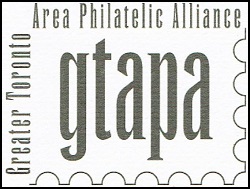
www.gtapa.org
The GTAPA is committed to promote and stimulate
the art of philately to all ages for fun,
culture, education, and friendship.





